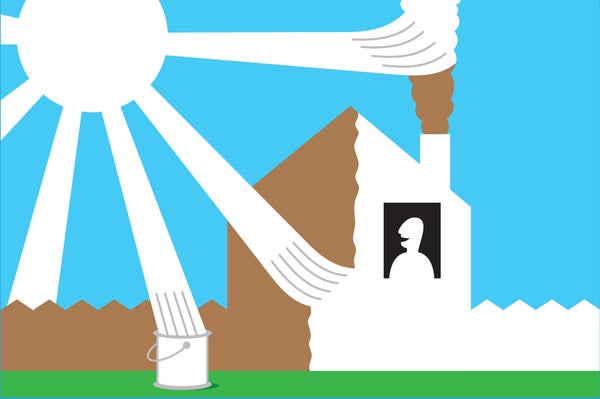This Paint Could Clean Both Itself and the Air
Thank you for reading this post, don't forget to subscribe!Recycled materials contribute to a pollutant-neutralizing paint

Thomas Fuchs
The pollutants clogging our skies aren’t just a health risk; they also cause ugly stains on buildings and other structures. To combat this, chemists have been working for years on a special type of paint that not only can clean itself but also may remove pollutants from the air.
This technology uses titanium oxide nanoparticles that jump-start chemical reactions. When an artificial ultraviolet light source shines on the paint, the nanoparticles react with pollutants to make them break down—theoretically removing them from nearby air and preventing a discoloring buildup. Companies already offer these so-called photocatalytic paints, but some chemists remain cautious about the products’ effectiveness and sustainability.
For a recent study in American Chemical Society Catalysis, researchers developed a new photocatalytic paint they claim works using UV rays from ordinary sunlight, making its self-cleaning properties easier to activate. They’ve also shown they can effectively produce this paint from recycled materials.
On supporting science journalism
If you’re enjoying this article, consider supporting our award-winning journalism by subscribing. By purchasing a subscription you are helping to ensure the future of impactful stories about the discoveries and ideas shaping our world today.
“One of the goals was that we minimize the use of synthetic reagents,” says study co-author Qaisar Maqbool, a chemist at the Vienna University of Technology. “We do this by using waste material like titanium scrap from industry and also using fallen leaves, which are organic waste.”
In photocatalysis, UV light excites the electrons in the titanium oxide nanoparticles, which interact with airborne water molecules to produce highly reactive hydroxyl radicals. These unstable chemicals attack pollutants that come in contact with the paint, converting them into less harmful substances such as carbon dioxide and water. The research team added phosphorus, nitrogen, carbon, and other elements to the nanoparticles’ structure, which reduced the amount of energy needed to spark the reaction and let it work via ordinary sunlight. In laboratory tests, these modified nanoparticles removed up to 96 percent of tested pollutants added to the paint’s surface.
“It is better to be able to use solar light to activate, as the paint can work passively, by itself,” says Antonio Nieto-Márquez Ballesteros, a chemist at the Technical University of Madrid. But a real-world setting would probably reduce its effectiveness, he adds. “Under laboratory conditions, it is a very small scale, and everything is very well controlled—all the parameters, such as temperature, humidity, flow rate of reactance or the concentration of pollutants—but you will never get those results at a real scale.”
The study authors stress that this work is just an initial step in their research. “I think it’s a very fundamental study,” says co-author Günther Rupprechter, a chemist at the Vienna University of Technology. Future research will confirm how effectively pollutants are neutralized from the air itself. “We don’t claim that we can remove all contamination from air,” he says, “but overall, it looks promising.”

